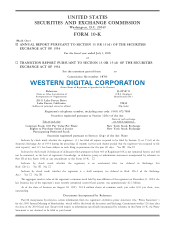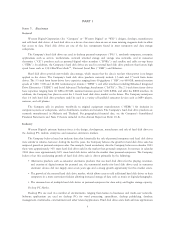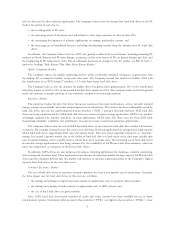Western Digital 2005 Annual Report Download - page 16
Download and view the complete annual report
Please find page 16 of the 2005 Western Digital annual report below. You can navigate through the pages in the report by either clicking on the pages listed below, or by using the keyword search tool below to find specific information within the annual report.Company sells its hard disk drive products directly and indirectly. The Company believes that trust in a manufacturer's
reputation and the establishment of strategic relationships have become important factors in the selection of a hard disk
drive, particularly in a rapidly changing technology environment.
Advances in magnetic, optical or other data storage technologies could result in competitive products that have
better performance or lower cost per unit of capacity than the Company's hard disk drive products. High-speed
semiconductor memory could compete with the Company's hard disk drive products in the future. Semiconductor
memory is much faster than magnetic hard disk drives, but currently is not competitive from a cost standpoint. Flash
memory, a non-volatile semiconductor memory, is currently much more costly and, while it has higher ""read''
performance attributes than hard disk drives, it has lower ""write'' performance attributes. Flash memory could become
competitive in the near future for applications requiring less storage capacity than that provided by hard disk drives.
For an additional discussion of competition, see Part II, Item 7, under the heading ""Risk Factors That May Affect
Future Results.''
Service and Warranty
Western Digital generally warrants its newly manufactured hard disk drives against defects in materials and
workmanship for periods of from one to five years from the date of sale depending on the type of product. The
Company's warranty obligation is generally limited to repair or replacement of the hard disk drive. The Company has
engaged third parties in Australia, Brazil, Canada, China, Germany, Hungary, India, Korea, Russia, Singapore, Thailand
and the United Arab Emirates to provide various levels of testing, processing and/or recertification of returned hard disk
drives for the Company's customers. In addition, the Company processes, tests and recertifies returned hard disk drives at
its own facility in the United States.
Manufacturing
Western Digital believes that it has significant know-how, unique product manufacturing process, and human
resources to continue to be successful and have the ability to grow, as necessary, its manufacturing operations. To be
competitive, Western Digital must manufacture high quality hard disk drives with industry leading time-to-volume
production at competitive unit costs. The Company strives to maintain manufacturing flexibility, high manufacturing
yields, and reliable products, while insisting that its suppliers provide high-quality components at competitive prices. The
critical elements of Western Digital's hard disk drive production are high volume, low cost assembly and testing, and
establishment and maintenance of key supplier relationships. By establishing close relationships with its strategic
component suppliers, the Company believes it is able to access best-of-class manufacturing quality. In addition, the
Company believes that its sourcing strategy currently enables it to have the business flexibility needed to select the highest
quality low cost of ownership suppliers as product designs and technologies evolve.
Hard disk drive manufacturing is a complex process involving the assembly of precision components with narrow
tolerances and thorough testing. The assembly process occurs in a ""clean room'' environment that demands skill in
process engineering and efficient utilization of the ""clean room'' layout in order to reduce the high operating costs of this
manufacturing environment. The Company's clean room manufacturing process consists of modular production units,
each of which contains a number of work cells.
The Company manufactures hard disk drives in Malaysia and Thailand. The Company continually evaluates its
manufacturing processes in an effort to increase productivity, sustain and improve quality and decrease manufacturing
costs. For example, during 2002, in response to an increase in demand and in order to capitalize on the local supplier
base, the Company completed the acquisition of a Thailand manufacturing facility. The Company continually evaluates
which steps in the manufacturing process would benefit from automation and how automated manufacturing processes
can improve productivity and reduce manufacturing costs.
In July 2003, the Company purchased substantially all of the assets of Read-Rite Corporation, formerly one of the
Company's suppliers of heads, including its wafer fabrication equipment in Fremont, California and its slider fabrication
facility in Bang Pa-In, Thailand. These assets are upgraded and enhanced as necessary to meet the demands of newer
technologies consistent with the Company's hard disk drive production facilities. The Company uses these facilities to
10
























